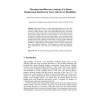Free Online Productivity Tools
i2Speak
i2Symbol
i2OCR
iTex2Img
iWeb2Print
iWeb2Shot
i2Type
iPdf2Split
iPdf2Merge
i2Bopomofo
i2Arabic
i2Style
i2Image
i2PDF
iLatex2Rtf
Sci2ools
HCI
2009
2009
Movement and Recovery Analysis of a Mouse-Replacement Interface for Users with Severe Disabilities
The Camera Mouse is a mouse-replacement interface for users with movement impairments. It tracks a selected body feature, such as the nose, eyebrow or finger, through a web camera and translates the user's movements to movements of the mouse pointer. Occasionally, the Camera Mouse loses the feature being tracked, when the user moves quickly or out of frame, or when the feature is occluded from view of the web camera. A new system has been developed to recognize when the tracked feature has been lost and to locate and resume tracking of the originally selected feature. In order to better understand the directions of movement which are most and least comfortable for users with disabilities, a game interface was developed to test the accuracy and speed of users across different trajectories. The experiments revealed that trajectories most comfortable for a user with severe cerebral palsy were along diagonal axes.
| Added | 18 Feb 2011 |
| Updated | 18 Feb 2011 |
| Type | Journal |
| Year | 2009 |
| Where | HCI |
| Authors | Caitlin Connor, Emily Yu, John J. Magee, Esra Cansizoglu, Samuel Epstein, Margrit Betke |
Comments (0)

